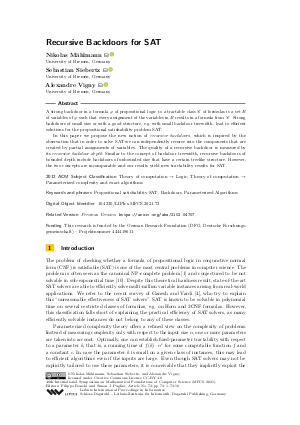Recursive Backdoors for SAT
Authors
Nikolas Mählmann  ,
Sebastian Siebertz
,
Sebastian Siebertz  ,
Alexandre Vigny
,
Alexandre Vigny 
-
Part of:
Volume:
46th International Symposium on Mathematical Foundations of Computer Science (MFCS 2021)
Part of: Series: Leibniz International Proceedings in Informatics (LIPIcs)
Part of: Conference: Mathematical Foundations of Computer Science (MFCS) - License:
 Creative Commons Attribution 4.0 International license
Creative Commons Attribution 4.0 International license
- Publication Date: 2021-08-18
File

PDF
LIPIcs.MFCS.2021.73.pdf
- Filesize: 0.86 MB
- 18 pages
Document Identifiers
Related Versions
- Previous Version https://arxiv.org/abs/2102.04707
Subject Classification
ACM Subject Classification
- Theory of computation → Logic
- Theory of computation → Parameterized complexity and exact algorithms
Keywords
- Propositional satisfiability SAT
- Backdoors
- Parameterized Algorithms
Metrics
- Access Statistics
-
Total Accesses (updated on a weekly basis)
0Document
0Metadata
Abstract
A strong backdoor in a formula φ of propositional logic to a tractable class C of formulas is a set B of variables of φ such that every assignment of the variables in B results in a formula from C. Strong backdoors of small size or with a good structure, e.g. with small backdoor treewidth, lead to efficient solutions for the propositional satisfiability problem SAT. In this paper we propose the new notion of recursive backdoors, which is inspired by the observation that in order to solve SAT we can independently recurse into the components that are created by partial assignments of variables. The quality of a recursive backdoor is measured by its recursive backdoor depth. Similar to the concept of backdoor treewidth, recursive backdoors of bounded depth include backdoors of unbounded size that have a certain treelike structure. However, the two concepts are incomparable and our results yield new tractability results for SAT.
Cite As Get BibTex
Nikolas Mählmann, Sebastian Siebertz, and Alexandre Vigny. Recursive Backdoors for SAT. In 46th International Symposium on Mathematical Foundations of Computer Science (MFCS 2021). Leibniz International Proceedings in Informatics (LIPIcs), Volume 202, pp. 73:1-73:18, Schloss Dagstuhl – Leibniz-Zentrum für Informatik (2021)
https://doi.org/10.4230/LIPIcs.MFCS.2021.73
BibTex
@InProceedings{mahlmann_et_al:LIPIcs.MFCS.2021.73,
author = {M\"{a}hlmann, Nikolas and Siebertz, Sebastian and Vigny, Alexandre},
title = {{Recursive Backdoors for SAT}},
booktitle = {46th International Symposium on Mathematical Foundations of Computer Science (MFCS 2021)},
pages = {73:1--73:18},
series = {Leibniz International Proceedings in Informatics (LIPIcs)},
ISBN = {978-3-95977-201-3},
ISSN = {1868-8969},
year = {2021},
volume = {202},
editor = {Bonchi, Filippo and Puglisi, Simon J.},
publisher = {Schloss Dagstuhl -- Leibniz-Zentrum f{\"u}r Informatik},
address = {Dagstuhl, Germany},
URL = {https://drops.dagstuhl.de/entities/document/10.4230/LIPIcs.MFCS.2021.73},
URN = {urn:nbn:de:0030-drops-145138},
doi = {10.4230/LIPIcs.MFCS.2021.73},
annote = {Keywords: Propositional satisfiability SAT, Backdoors, Parameterized Algorithms}
}
Author Details
Funding
This research is funded by the German Research Foundation (DFG, Deutsche Forschungsgemeinschaft) - Projektnummer 444419611.
References
-
Stephen A Cook. The complexity of theorem-proving procedures. In Proceedings of the third annual ACM symposium on Theory of computing, pages 151-158, 1971.

-
Marek Cygan, Fedor Fomin, Lukasz Kowalik, Daniel Lokshtanov, Dániel Marx, Marcin Pilipczuk, Michał Pilipczuk, and Saket Saurabh. Parameterized Algorithms. Springer Publishing Company, Incorporated, January 2015.

-
Bistra Dilkina, Carla P. Gomes, and Ashish Sabharwal. Backdoors in the context of learning. In SAT, volume 5584 of Lecture Notes in Computer Science, pages 73-79. Springer, 2009.

-
Vijay Ganesh and Moshe Y. Vardi. On the unreasonable effectiveness of SAT solvers. In Beyond the Worst-Case Analysis of Algorithms, pages 547-566. Cambridge University Press, 2020.

-
Robert Ganian, M. S. Ramanujan, and Stefan Szeider. Backdoor treewidth for sat. In International Conference on Theory and Applications of Satisfiability Testing, pages 20-37. Springer, 2017.

-
Robert Ganian, M. S. Ramanujan, and Stefan Szeider. Discovering archipelagos of tractability for constraint satisfaction and counting. ACM Transactions on Algorithms, 13(2):1–32, 2017.

-
Serge Gaspers, Neeldhara Misra, Sebastian Ordyniak, Stefan Szeider, and Stanislav Živný. Backdoors into heterogeneous classes of SAT and CSP. Journal of Computer and System Sciences, 85:38–56, 2017.

-
Serge Gaspers and Stefan Szeider. Backdoors to satisfaction. In The Multivariate Algorithmic Revolution and Beyond, pages 287-317. Springer, 2012.

-
Serge Gaspers and Stefan Szeider. Strong backdoors to bounded treewidth SAT. 2013 IEEE 54th Annual Symposium on Foundations of Computer Science, 2013.

-
Russell Impagliazzo, Ramamohan Paturi, and Francis Zane. Which problems have strongly exponential complexity? Journal of Computer and System Sciences, 63(4):512-530, 2001.

-
N. Nishimura, P. Ragde, and Stefan Szeider. Detecting backdoor sets with respect to horn and binary clauses. In SAT, 2004.

-
Sebastian Ordyniak, André Schidler, and Stefan Szeider. Backdoor DNFs. Technical Report AC-TR-21-001, Algorithms and Complexity Group, TU Wien, 2021.

-
Neil Robertson and Paul D Seymour. Graph minors V. excluding a planar graph. Journal of Combinatorial Theory, Series B, 41(1):92-114, 1986.

-
Marko Samer and Stefan Szeider. Backdoor trees. In Proceedings of the 23rd National Conference on Artificial Intelligence - Volume 1, AAAI'08, page 363–368. AAAI Press, 2008.

-
Marko Samer and Stefan Szeider. Algorithms for propositional model counting. Journal of Discrete Algorithms, 8(1):50-64, 2010.

-
Marko Samer and Stefan Szeider. Fixed-parameter tractability. Technical Report AC-TR-21-004, Algorithms and Complexity Group, TU Wien, 2021. Chapter 17, Handbook of Satisfiability, 2nd Edition, 2021.

-
Ryan Williams, Carla P. Gomes, and Bart Selman. Backdoors to typical case complexity. In Proceedings of the 18th International Joint Conference on Artificial Intelligence, IJCAI'03, page 1173–1178. Morgan Kaufmann Publishers Inc., 2003.

-
Edward Zulkoski, Ruben Martins, Christoph M. Wintersteiger, Robert Robere, Jia Hui Liang, Krzysztof Czarnecki, and Vijay Ganesh. Learning-sensitive backdoors with restarts. In CP, volume 11008 of Lecture Notes in Computer Science, pages 453-469. Springer, 2018.

